Professional drivers may need to use laundromat equipment to wash and dry laundry while on the road so that they can wear clean clothes and maintain their professionalism.
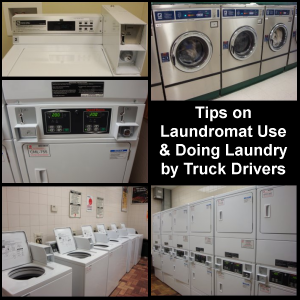 Even drivers who have a home support team may occasionally need to launder garments if they can’t get home by the time their clean clothing supply runs out.
Even drivers who have a home support team may occasionally need to launder garments if they can’t get home by the time their clean clothing supply runs out.
When we became homeless in late 2009, we quickly became re-acquainted with the need to wash and dry clothing in a non-residential setting.
In the process, we learned some money saving tips about using laundromat facilities.
Our only advice on how to wash and dry clothing may be summarized as:
- separate lights from darks and delicate clothing from heavy duty,
- add cleaning aids (detergent, bleach, fabric softener) to the washer according to the manufacturer’s recommendations and machine instructions,
- wash clothing on appropriate temperature and fabric settings, and
- dry clothing on appropriate temperature settings.
On Changing Clothes
The amount of clothing that you need to launder is directly proportionate to what you use.
You will need to determine for yourself the frequency with which you change your clothes.
We have found that when trucking regionally, we can wear our “outside clothes” for two days as long as we change socks and underwear every day.
Mike makes it a practice to shower at least every other day on the road, thus giving him the opportunity to do a complete change of clothing.
There is a delicate balance between good personal hygiene and the amount of clothes one uses on the road.
You may strike a different balance than we do.
Laundry Bags, Laundry Baskets and Carts
Years ago when we teamed, we used a good-sized cardboard box as a laundry basket.
We decided to do our laundry at a truckstop in Ohio.
We started washing our clothes in the washers, left the box in plain view on top of the machines, and left long enough to go eat a quick meal in their on-site restaurant.
When we returned, our box was gone!
We learned that the janitor on duty had seen fit to tear down (dismantle) and throw away our box!
We complained, but there was nothing we could do.
The box could not be repaired.
Needless to say, that truckstop is not one of our favorites today.
We recommend that, at a minimum, you take with you some clean trash bags (maybe 30 gallon size) for temporary storage of your laundry.
Never Leave Your Clothes?
Some people advise never leaving a washer or dryer in a commercial facility.
One person we spoke with in early 2010 told us that someone had actually stolen clothing out of a laundromat washing machine!
The clothing wasn’t just moved from the washer after the washing cycle finished; it was stolen.
So, be on your guard and stick close by.
The Advantage of Mesh Bags
Be sure to take with you on the road something appropriate in which to store both your clean and dirty laundry.
We have had success in using two industrial strength laundry bags constructed with:
- a mesh-type material to allow the clothing to “breathe,”
- a drawstring to keep the clothes from falling out, and
- a strap that allows the bag to be carried over one’s shoulder.
Having a breathable bag may be important if you set aside clothing, dishcloths and dishtowels that are the slightest bit wet.
If they are enclosed in a plastic bag, they can start to mold.
If possible, we recommend that damp and wet articles be “line dried” in the truck prior to being put in a laundry bag.
We are pleased that our laundry bags can be washed along with our clothing (so that the clean clothes aren’t put back in a dirty bag).
We noted that the stiffness of the new bags worked out after the first wash (evidently meaning that they had had starch in them).
Laundry Carts
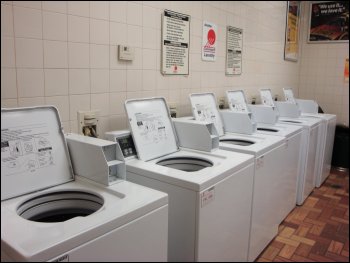 In commercial laundromats, the owner often makes available laundry carts designed with a rack over the top to move washed goods between the washers and dryers, then from dryers to the tables.
In commercial laundromats, the owner often makes available laundry carts designed with a rack over the top to move washed goods between the washers and dryers, then from dryers to the tables.
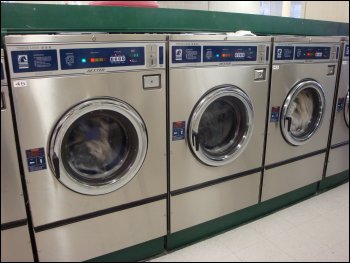 Depending on the size of a truckstop laundromat, you may not have a cart or even have a table upon which to fold your laundry.
Depending on the size of a truckstop laundromat, you may not have a cart or even have a table upon which to fold your laundry.
You may have to make do with folding your laundry on top of a dryer.
We have found it more convenient to fold laundry in the facility.
This allows us to stack our garments and linens neatly back into the laundry bag instead of just jumbling them together.
That way, they can be neatly placed in the designated storage area in the truck.
Where to Wash and Dry Laundry
Your options for doing laundry on the road include (but may not be limited to) these:
- at the home of a friend;
- at your company’s terminal(s);
- at a truck stop;
- at the hotel/motel where you may be staying;
- in your truck if it is equipped with a washer or dryer;
- by using a portable washing machine and line drying in your truck; or
- at a self-service commercial laundry facility (aka laundromat, coin laundry or washateria).
Your choices may be limited to where you can park your truck (at least the tractor, but possibly the trailer also).
Where to Find a Commercial Laundry
Is there a site online where drivers can find a laundromat near them, wherever they are on the road?
The Coin Laundry Association touts itself as “The only national trade organization that services the coin laundry industry.”
While their site has a search form through which interested people can look for an area laundry, they list only coin laundries that are members (for a fee).
Many coin laundries are not members of this association and are therefore not listed in their directory.
One listing of laundry facilities that you can definitely access by truck on the road is at truck stops, a complete listing of which you can find in the National Truck Stop Directory or The Trucker’s Friend, listed here through Amazon.com, with which we have an affiliate relationship.
[adinserter block=”3″]
It has a comprehensive overview of all truck stops in the USA. We referred to our copy of this publication on the road often.
Thanks to our Twitter friend Monongahela Misfit (formerly “monmisfit”), another way to find laundromats is through the YP (Yellow Pages) “app” on a Smartphone. This app will allow you to find local businesses wherever you are.
Please be advised that local businesses found this way may or may not have parking for full-sized big trucks. Depending on the business, they may not even have parking large enough for a bobtail. When you find a likely business, you may want to check the location via satellite view on Google Maps to see the parking lot “from the sky.”
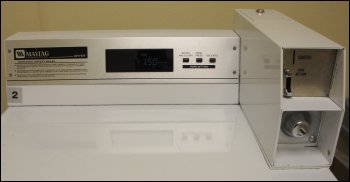 The panel on a typical coin washing machine.
The panel on a typical coin washing machine.
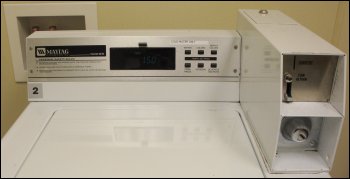 A Maytag coin operated washing machine.
A Maytag coin operated washing machine.
This one has more settings to choose from.
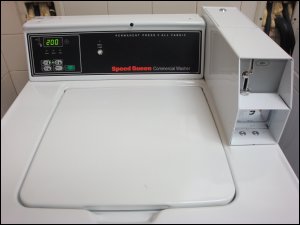 A Speed Queen coin operated washing machine.
A Speed Queen coin operated washing machine.
Using a Coin Laundromat
If you plan to use a coin-operated laundromat, you will need to have enough change (usually quarters) to feed the machines.
Most non-truckstop facilities have change machines to convert “paper money” into coins.
As these change machines may have an upper limit on the denomination of bills they convert, you may wish to keep a supply of smaller denomination bills on hand if you do not keep a supply of suitably sized coins for laundry purposes.
All truck stops with laundry equipment that we have seen have vertically mounted washers with agitators.
Personally, we prefer using horizontally mounted washers without agitators, as they are gentler on the clothes.
Sometimes, you can also fit more clothes into a washer that is horizontally mounted than one with a vertically mounted agitator.
We have found variations between washers and dryers.
For example, the first two photos above offer different washing settings, the top giving only three choices, the bottom giving six.
All machines clearly list the operation price. Operation costs may vary based on location.
Laundry Supplies
Our personal packing list includes several laundry supplies, one of which is quarters to operate the washers and dryers.
Please note that if you buy supplies from a vending machine or in the travel store at a truckstop, you could be paying greatly inflated prices compared to what you could buy in a retail or discount store.
You will want to invest in a laundry detergent that has the ability to remove dirt, body oils, and other contaminants.
For example, in January 2010, as Vicki was exiting the tractor Mike drives, she accidentally rubbed against the air faring which was coated with road salt (to keep the roads free of snow and ice).
Some drivers may need to clean up after their pets.
And there may be times when you accidentally cut yourself and need to remove blood from a garment.
Consumer rating agencies may provide comparisons of laundry supplies and their ability to remove certain soils.
Washing Machine Basket Capacity
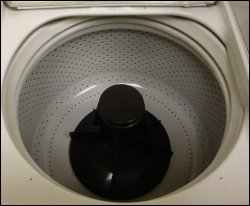 One of our pet peeves about using publicly accessible laundry facilities is that the capacity of the standard washing machines is so much less than the “large capacity” washer we use at home.
One of our pet peeves about using publicly accessible laundry facilities is that the capacity of the standard washing machines is so much less than the “large capacity” washer we use at home.
The photo here shows the basket of a Maytag coin operated washing machine.
We haven’t checked the sizes, but we would estimate that it would take two loads to wash in a laundromat that we can wash in one load at home.
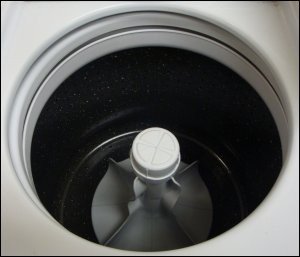 Of course, basket sizes differ.
Of course, basket sizes differ.
This is the basket of a Speed Queen coin-operated washing machine.
As big as a large capacity home washing machine may seem to be, it is still not large enough to wash a sleeping bag.
Periodic laundering of a sleeping bag will require the use of a commercial facility with oversized equipment (which many truck stops do not have).
Super Cycle
Some washing machines have what is called a “super cycle.”
In our area, this means to let the machine spend an extra 3 minutes on the wash cycle.
In our travels, we have found that it costs one quarter ($0.25) more for this feature.
 This photo shows the display for a standard washing cycle on a coin-operated machine.
This photo shows the display for a standard washing cycle on a coin-operated machine.
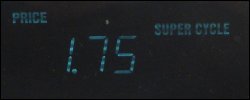 This photo shows the display for a “super cycle” washing cycle on a coin-operated machine.
This photo shows the display for a “super cycle” washing cycle on a coin-operated machine.
If you have particularly dirty clothes (from road dirt, grease, accidentally brushing by a dirty trailer, etc.), pre-treating the dirty spots and setting the washer for an extra 3 minutes on the wash cycle can help.
Loading Washers
Never overload a washing machine with laundry.
Horizontally mounted washers are a little more forgiving than vertically mounted ones, but even they have their limits.
We once used a pair of vertically mounted washing machines at a truckstop in north Georgia.
We were sensitive to their capacities and divided the clothes into approximately equal amounts.
We put the dark outer garments, including Mike’s jeans, into one washer, believing that the machine had plenty of room to agitate.
But during the first few minutes of washing, it became apparent that something was wrong.
We tried moving the garments around to loosen them up (thinking that might have been the problem when it suddenly “stopped”), but that didn’t solve the problem.
Only when the other washer had completed its cycle and we moved about half of the clothes out of the “overloaded” washer into it did the first one start up again.
We certainly never intend to wash clothes there again, as we felt we were cheated.
Oversized Washers
Many commercial laundromats have a variety of sizes of washers.
There are “double load,” “triple load” and “mega load” washing machines.
We have found that the larger the coin-operated washing machine, the higher the cost to operate it.
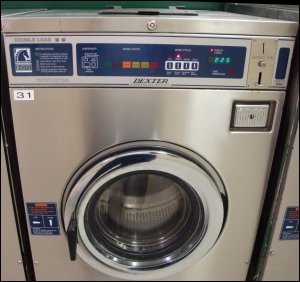 A Dexter Double Load washing machine requires 13 quarters to operate. These machines are typically found in public laundromats.
A Dexter Double Load washing machine requires 13 quarters to operate. These machines are typically found in public laundromats.
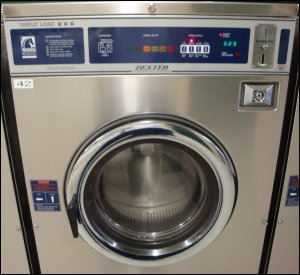 A Dexter Triple Load washing machine, which requires 13 quarters to operate.
A Dexter Triple Load washing machine, which requires 13 quarters to operate.
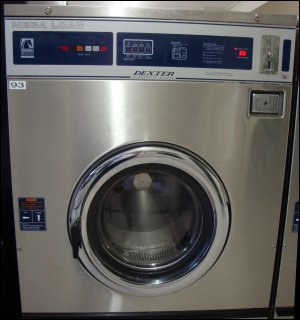 A Dexter Mega Load washing machine, which requires 20 quarters to operate and can wash 55 pounds of dry clothing.
A Dexter Mega Load washing machine, which requires 20 quarters to operate and can wash 55 pounds of dry clothing.
When we wash our sleeping bags, we use the “mega load” size washer, which according to the sign in one coin laundry we have used is able to wash 55 pounds of dry clothing.
To the left, you will see photos of the oversized washers.
In our area as of late 2009:
- the double load washer costs $2.25 to operate,
- the triple load costs $3.25 to operate, and
- the mega load costs $5.00 to operate.
In mid-2010, Vicki noticed that the cost to operate a triple load washing machine had gone up to $3.50.
Centrifuge Cuts Drying Time
The laundromat that we used to use in our home town had a centrifuge in which washed laundry was spun at a high speed to remove more water than the washing machine could.
For $0.75 per large load, we have found that using a centrifuge is a great help in cutting drying time.
So the claim on the front of the machine was absolutely accurate, especially when drying heavy articles like jeans.
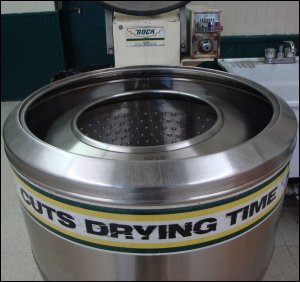 The Bock centrifuge spins clothes at a high speed to pull more water out of washed clothes so that they dry faster in the dryer. It cuts drying time.
The Bock centrifuge spins clothes at a high speed to pull more water out of washed clothes so that they dry faster in the dryer. It cuts drying time.
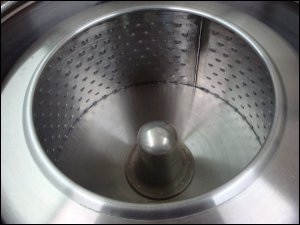 The basket of the Bock centrifuge into which washed clothes are placed for removing more water prior to drying. It cuts drying time.
The basket of the Bock centrifuge into which washed clothes are placed for removing more water prior to drying. It cuts drying time.
For a period of time in mid-2010, the centrifuge at this laundromat was broken.
It took much longer to dry our clothes — especially the heavy clothes like jeans.
One of the workers said that the company that manufactured the centrifuge had gone out of business 10 years ago and they had to “cannabalize” other machines to fix it.
According to the same worker, new commercial washers have a high-powered spin setting that extract water just as well as the centrifuge.
However, we have never used any of those and we doubt that any of the truck stops would have any of them.
Dryer Heat
Commercial dryers tend to heat up much hotter than home dryers.
The heat can adversely affect anything with elastic, spandex, or other heat-sensitive fabrics.
So please exercise chare in drying items with those materials.
When operating a stacked dryer -– especially those that have only one coin drop for both top and bottom dryers -– make sure you select for drying the dryer with your laundry in it.
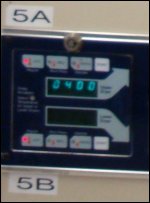 The close-up of the panel on stacked dryers in a laundromat, which shows 4 minutes of drying time left on the top dryer.
The close-up of the panel on stacked dryers in a laundromat, which shows 4 minutes of drying time left on the top dryer.
This is an example of a coin-operated stacked dryer that has two separate coin feeding slots, one each for top and bottom dryers.
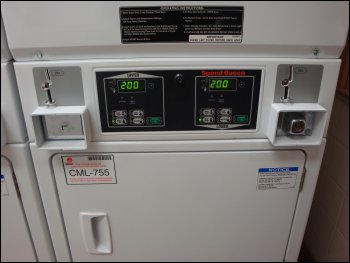 The panel from a set of stacked dryers in a truckstop, showing the coin slots, temperature settings and which slots and settings go with which dryer.
The panel from a set of stacked dryers in a truckstop, showing the coin slots, temperature settings and which slots and settings go with which dryer.
The slot and setting on the left are for the machine up top.
The slot and setting on the right are for the machine down below.
At the home terminal of one of Mike’s regional trucking companies, there is a single non-commercial washer and dryer.
Using these machines meant that we can wash and dry only one load at a time.
It always takes longer to dry heavier garments like Mike’s jeans and Vicki’s socks than it takes to wash a second load of clothes.
So the dryer limits the ability to process laundry.
You will need to budget your time appropriately for doing laundry.
Depending on the washer(s) and dryer(s) you use, you could spend an hour or more washing and drying your laundry.
Plan to spend more time on the process if the number of machines is limited or there are many other users.
We have found that public laundromats are heavily used on the weekends, particularly Saturdays.
If you find that you need to do laundry and it is going to take a while to either load or unload your trailer — and you are allowed to drop your trailer — ask if there is a laundromat nearby to which you can bobtail.
You might be able to take advantage of the time that you ordinarily would have been waiting anyway.
Examples of dryers we have found are pictured here:
 Typical laundromat coin operated dryers.
Typical laundromat coin operated dryers.
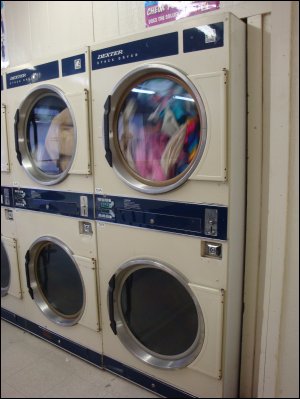 Coin-operated stack dryers in a laundromat.
Coin-operated stack dryers in a laundromat.
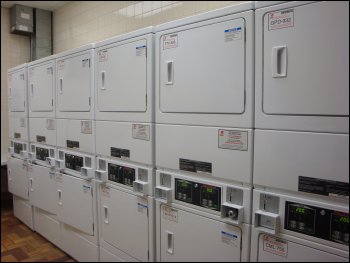 A row of coin-operated stack dryers in a truckstop.
A row of coin-operated stack dryers in a truckstop.
Beware of the Dryer “Gotcha”
Coin-operated commercial dryers work one of two ways:
- on a per-coin basis (such as $0.25 per X amount of time) or
- on a per-cycle basis (such as $2.00 per Y amount of time).
In the laundromats we have used, we have never seen a sign posted over a dryer stating the length of time per the minimum deposit amount.
This is a problem that we feel needs to be corrected.
While some dryers have an indicator stating how much time is left on the current drying cycle, we wish all of them did.
In the event that you have extra heavy garments (like jeans), you may need more drying time.
Some dryers require the deposit of the full amount of money for another full cycle of drying, whether or not you need that much time.
For example, if the dryer requires $2 to operate for a one-hour cycle and you only need another 15 minutes of drying, you will be paying for 45 minutes of use that you don’t need!
Prorating that to $0.50 for each 15-minute period, you would be throwing away $1.50!
You might be better served to line dry whatever is still damp in your truck.
In standard laundromats we have used, you can feed quarters into dryers for about 6 minutes of drying each.
(Time per quarter may vary by location.)
We’re going to contrast
- Per-coin-fed: 6-minute increments at $0.25 each and
- Per-cycle-fed: 60-minute increments at $2.00.
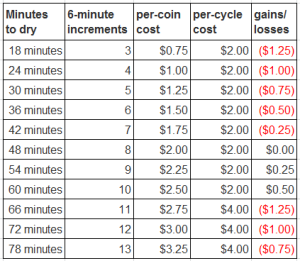
One Experience at a Truck Stop Laundromat
We hope you learn from our experience at a truckstop in Kentucky.
We knew that the dryer wasn’t going to completely dry Mike’s jeans on one per-cycle drying cycle.
Based on our experience in using per-coin machines, we fed the dryer with another full round of quarters before the dryer stopped the first cycle.
However, the second set of quarters did not add time to the cycle!
We had to wait until the current cycle was over to add more quarters.
The machine basically stole that one set of quarters.
Be aware of this.
In general, we have found that non-truckstop laundromats provide a better value for the money than truckstop laundromats.
Not only that, but in general, a commercial facility usually has more machines.
FREE Drying?
We had a positive experience at a laundromat in Greensboro, NC, not far from the home terminal of one of the regionally trucking companies for which Mike drove.
The signs near the dryers said that customers could dry their laundry for free as long as they washed their clothes there.
Excellent!
We’ll remember that place!
![]() Money saving tip: You may not have a choice about the laundromat facilities you use when you’re on the road.
Money saving tip: You may not have a choice about the laundromat facilities you use when you’re on the road.
Don’t try to make the machines do more than they are supposed to (like putting too many clothes into a washing machine).
You’ll find that that tack may cost you more time or money or both in the long run.
If you do have a choice on where to wash your clothes, seek the best value per machine you can find.
For example, if a double loader costs $2.25 to use and a triple loader costs $3.25, the triple loader could be a slightly better value, but only if you have the amount of laundry to fill it.
A centrifuge can help cut down on drying time.
Horizontally mounted washing machines do a good job of spinning out water.
Seek a per-coin dryer rather than a per-cycle dryer, especially if you have heavy garments that require only a little more than one full “cycle” worth of coins.
Don’t use too much soap, bleach or fabric softener.
If you use more than the optimum amounts for each, you’ll be wasting them.
Besides, washers may not be able to remove all of the soap from garments.
If too much soap is left in the clothing, it can cause you to itch when you wear the garments.
Or it may take some washing machines much longer to get all the soap out, forcing you to wait longer in the laundromat than you’d planned for the cycle to end.
To avoid problems (including potential theft), stay near the machines where your clothes are being washed and dried.
If you have Internet access, you can find some coin laundromats listed online.
Return from Tips on Laundromat Use and Doing Laundry by Truck Drivers to our Trucker Services page or our Truck Drivers Money Saving Tips home page.







